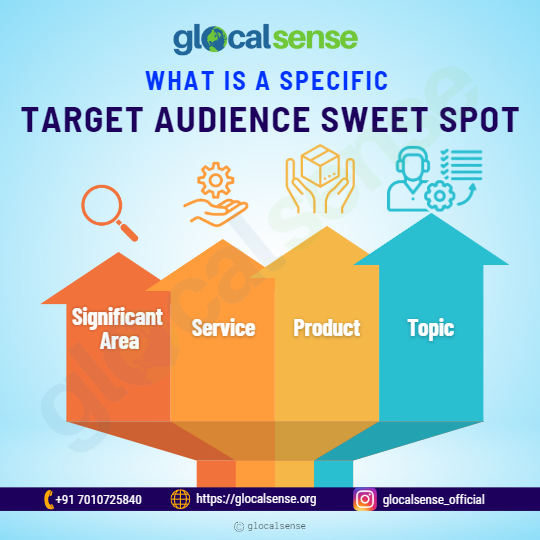In recent times, many businesses have delivered great and relevant content on topics they think their target audience is interested in. Only to discover that their content has run out of steam. Others find themselves developing material that their audience enjoys but have nothing to do with their products or services. Creating content that meets your target audience’s sweet spot can be hard.
Others find content that their audience likes but have nothing to do with their products or services. It’s easy to fall back into the habit of creating content that doesn’t quite hit your target audience’s sweet spot. To avoid this, you should first identify the sweet spots of your target audience.
Joe Pulizzi says in his book Epic Content Marketing: “Your sweet spot is the intersection between your customers’ pain points and where you have the most authority with your stories. This takes us back to one of the original questions: where can you be the leading expert in the world?”
What is a Specific Target Audience Sweet Spot

Your sweet spot is a significant area, product, service, or topic that sets your brand apart from the competitors while meeting the target audience’s needs.
It should be a piece of cake to create good content on this sweet spot once you’ve spotted it. If you’re successful, you’ll notice that your marketing efforts are getting the best response possible. It gives you the edge you need to secure your brand’s position as a market leader.
Companies with a very niche product or service may find it easier to pinpoint the audience’s sweet spot because they have a particular target demographic.
How to Identify the Audience’s Sweet Spot Content?
When it comes to content marketing, your sweet spot is the intersection of your brand’s expertise and purpose with your target audience’s interests, questions, and pain points.
To find the sweet spot, you must first determine what your business excels at and what your target audience is genuinely interested in.
Discover what your brand is best at
It’s not always about going on the latest bandwagon when it comes to writing content that understands the audience of the need. Instead, it’s all about identifying your brand’s strengths.
What defines your company? What differentiates you from your competitors? It could be a particular product or service. It could also be your outstanding customer service.
Take, for example, Volvo. The Swedish carmaker does not claim to make the world’s fastest or most innovative cars. It’s not their greatest strength. They are, however, and have been for decades, the champions of automotive safety.
Volvo’s purpose was to introduce safe vehicles, positioning them as industry leaders and a top choice for family vehicles.
Simple Steps to find your Target Audience Sweet Spot
You will need to prioritize your resources unless you have an infinite budget. The most efficient way to achieve this is to identify your ideal sweet spot.
Start by capturing information on your ‘best customers,’ such as who they are, where they work, and why they are a good fit for the company.
“The sweet spot is a place where a combination of factors results in a maximum response for a given amount of effort.” – Wikipedia.
Finding your sweet spot(s) will simplify content creation that doesn’t match your sweet spot isn’t worth your time. You should only write material that will get the most out of your efforts.
Understand the topics where your customers’ interests and your expertise intersect (the sweet spot). When interacting directly with customers in your target markets, this area will set the tone and message of your content.
- Which features of your product are the most popular with customers?
- Do you have many target markets in thought?
- What problems do you assist them with?
- What value do you make to their lives?
- What differentiates you from the competitors?
- Find customers who actively promote your products and services.
- Let them describe why they like you; what values do you even have in common?
Knowing where and how your customers consume your content allows you to create content that resonates with the broadest possible audience segment.
- For the most impact, content must be shared and accessible.
- Are customers reading on the internet, watching videos, or using a mobile device?
- Create content that is suitable for a particular audience.
- Post new content regularly to keep customers interested and talking to you.
– To start, think about who they are in terms of the key people involved in the buying process, such as:
- What are their responsibilities?
- What are the issues they’re having?
- What are their common goals or objectives?
– Second, find out where they work and write down details such as industry sector, geography, function, company size, and their potential value to you.
– Finally, note down why you believe they’d be an excellent target for you.
Determine:
- What difficulties you can address for them
- What issues keep them up at night
- How familiar they are with your brand
- How much education they will require.
The meeting of these three areas is your sweet spot, and this is where you should spend your energy and resources.
The Sales Sweet Spot: 4 Stages of the Content Marketing Sales Funnel

Nowadays, content marketing gets treated as an “extra” service. Some business owners believe that while content marketing might help sales, it cannot support the entire funnel.
However, it’s likely incorrect!
The sales funnel for content marketing can be incredibly valuable to your company. When done effectively, content can take potential customers through the sales process and turn them into paying customers.
Stage 1: The Introduction
The introduction is at the very top of the content marketing funnel. This stage is your company’s excuse to prove “Hello, world!” “We are here.”
It’s also your first opportunity to introduce a rapport with your audience. At the same time, the introduction is primarily about gaining visibility and familiarising new audience members with your brand. It would be best if you also wanted to make a big enough impression that they remember you and want to move on to the next stage of your content marketing sales funnel.
Some paid ads, guest posts, or viral video content are probably on your mind today. Anything that will help you break through the noise or connect with an existing audience.
Stage 2: The Invitation
You want to invite your audience to become friends once you’ve caught their attention. So, you’re encouraging your new audience to connect with your brand at the invitation stage. This stage may include inviting them to follow you on social media, subscribe to your newsletter, or read your blog.
You want your invitation to highlight your most important content, no matter what it is. Make it clear to your new audience that you have a lot to offer and are willing to share it.
Instead of trying to sell a product, concentrate on creating a relationship. Make it simple for people to connect, and don’t put too many barriers in their way. They won’t move down the sales funnel if accepting your invitation is too difficult.
Stage 3: The Superhero Sequence
This stage is the moment for you to show off your skills. At this point in the superhero sequence, you’re ready to find out and fix your consumers’ problems.
The superhero sequence allows you to get incredibly creative with your content. You get to flex your muscles by pointing to the products or services you offer that can truly assist the customer in solving their problem.
Here, don’t restrict yourself to blog articles or one-pagers. At this point, e-books, webinars, and other in-depth content will be necessary. Make sure you have much good information to help your prospects understand how your solutions help customers solve their problems.
Stage 4: The Decision
The decision is the final stage. The bottom of the funnel is where the prospect must decide whether or not to make a purchase or if it is not ready to commit to your business.
At this point, the content should be encouraging without being forceful, and it may be necessary to stray from strictly content to get the decision made. Encourage your prospects to call you for sales, and you might be able to close the deal.
Instead of focusing only on closing the sale, make customers feel at ease with their decision. For example, if a buyer feels forced to buy, they may be dissatisfied with their decision and leave immediately.
Content marketing can be an efficient approach to bringing leads and prospects through your sales funnel. You can quickly and efficiently get new opportunities through the buying process if everything is set up correctly and the right content is in place.
Limiting your distance from the activity will keep you “sweet-spot-on” with content that:
- Addresses the concerns of your customers
- Endorses the expertise of your business
- Responds to your audience’s top priorities
- Promotes the value proposition of your company.
- Joins the social conversation by connecting with users where they live.
- Customers become brand advocates as the content becomes highly shareable.
Conclusion

Make a note of your sweet spot once you’ve found it. Include the description in your editorial calendar as part of your content strategy. Ensure consistency in messaging and brand authenticity throughout your networks by getting everyone who creates content focused. To maintain credibility, keep your content inside your field of expertise.
However, don’t stray too far from your identified sweet spot/s without creating an organic relationship. That points back to that sweet spot when your company grows or your content marketing/social media measurements and metrics indicate that change is required. Make logical connections between where you are and where you want to go, building authority and building your reputation as a respected thought leader and expert along the way.
It’s essential to monitor and measure the success of your content marketing and stay in touch with your target audiences.
